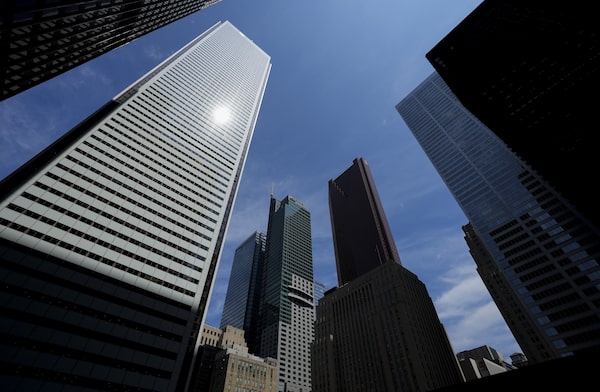
In the near term, major Canadian pension funds have built up a considerable cushion against losses, according to a report from Fitch Ratings Inc.Nathan Denette/The Canadian Press
Canada’s largest pension funds will likely take more losses on real estate and see defaults on private loans rise over the coming year, but have enough financial flexibility to mostly avoid having to sell assets at depressed prices, according to a report from Fitch Ratings Inc.
A higher cost of debt and slower economic growth have created a tough investing environment, pushing down the value of some private assets that pension funds own. That pressure has been most noticeable in real estate, where almost all of the country’s largest pension fund managers suffered losses ranging from 5 per cent to nearly 16 per cent, erasing billions of dollars of asset value last year.
Some pension fund chief executive officers have signalled that the worst pain may be over for real estate investors as central banks have started to cut rates, giving hope that the cost to borrow money could ease. According to Fitch, however, property values “are still adjusting to higher borrowing costs, a scarcity of available financing and a general repricing of assets,” especially office properties that have suffered from falling demand as hybrid working takes hold.
“There are a lot of mortgages that are yet to mature over the next year, year and a half,” Dafina Dunmore, a senior director at Fitch, said in an interview. “To the extent that there is pressure to refinance – which we certainly expect there to be, certainly for office properties – then you’ll see some continued losses over the foreseeable future.”
Private credit has been one of the best-performing asset classes for some large pension funds in recent years, often earning double-digit percentage gains. But high interest rates have also driven up costs to private borrowers, and the market has grown crowded with lenders.
There are no signs of widespread losses on private loans among major pension funds, and the loans tend to be backed by significant collateral. But defaults are rising and as more loans go bad, pension funds that invest directly in private credit “will be put to the test with respect to their workout capabilities,” Ms. Dunmore said.
“We do expect more losses to come in that portfolio, just given the increased competition,” she said. “And as competition grows, in terms of capital providers, that puts pressure on deal terms and pricing.”
In the near term, major Canadian pension funds have built up a considerable cushion against losses. They are accustomed to holding tens of billions of dollars in cash and other liquid assets that give them breathing room to pay pension obligations, make new investments or meet other financial obligations. The liquidity levels maintained by Canadian plans are “viewed as exceptionally strong,” Ms. Dunmore said, and “we have seen a few plans to build additional liquidity, given the volatility that we face.”
Fitch rates three of the largest Canadian pension funds – the Caisse de dépôt et placement du Québec, Public Sector Pension Investment Board and Ontario Municipal Employees Retirement System – and has assigned AAA long-term default ratings to each. Canada’s eight largest pension funds collectively controlled about $2.1-trillion of assets, as of Dec. 31.
For most of the past decade, pension funds have invested an ever larger share of their portfolios into private assets, seeking higher returns when interest rates were at ultralow levels. Now, as funds receive new contributions from members or look to put the proceeds from selling assets back to work, they are shifting more of that cash into bonds, which offer attractive returns with low risk at a time when interest rates are high.
Private assets will remain a major part of large pension funds’ portfolios, as investment executives chase premium returns, but funds are already trimming their exposure in places, rebalancing the mix of their investments.
“In a higher-rate environment, taking the additional risk makes less sense than maybe it did a decade ago,” Ms. Dunmore said.